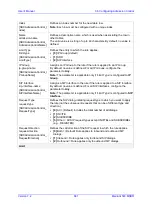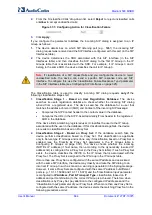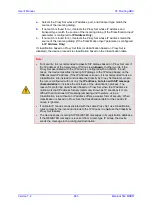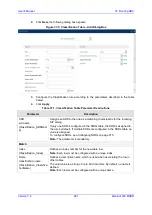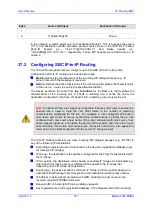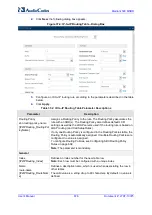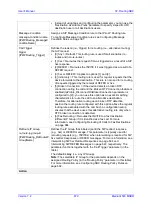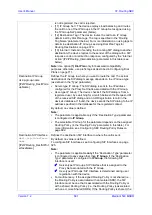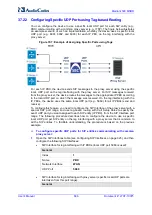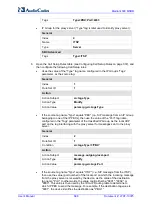
User's Manual
674
Document #: LTRT-10375
Mediant 500 MSBR
♦
SIP 408 Timeout or no response (after timeout).
•
The DNS resolution includes IP addresses that the device has yet to try (for the
current call).
Messages are re-routed with the same SIP Call-ID and CSeq header fields (increased
by 1).
Note:
If the Proxy Set (see Configuring Proxy Sets on page 348) associated with the
destination of the call is configured with multiple IP addresses, the device first
attempts to route the call to one of these IP addresses, starting with the first listed
address. Only when the call cannot be routed to any of the Proxy Set’s IP addresses
does the device search the IP-to-IP Routing table for an alternative routing rule for the
call.
Load Balancing:
You can implement load balancing of calls, belonging to the same
source, between a set of destination IP Groups known as an
IP Group Set
. The IP
Group Set can include up to five IP Groups (Server-type and/or Gateway-type only)
and the chosen IP Group depends on the configured load-balancing policy (e.g.,
Round Robin). To configure the feature, you need to first configure an IP Group Set
(see Configuring IP Group Sets on page 695), and then assign it to a routing rule with
'Destination Type' configured to
IP Group Set
.
Re-routing SIP Requests:
This table enables you to configure "re-routing" rules of
requests (e.g., INVITEs) that the device sends upon receipt of SIP 3xx responses or
REFER messages. These rules are configured for destinations that do not support
receipt of 3xx or REFER and where the device handles the requests locally (instead of
forwarding the 3xx or REFER to the destination).
Least Cost Routing (LCR):
If the LCR feature is enabled, the device searches the
routing table for matching routing rules and then selects the one with the lowest call
cost. The call cost of the routing rule is done by assigning it a Cost Group. To
configure Cost Groups, see Least Cost Routing on page 245. If two routing rules have
identical costs, then the rule appearing higher up in the table (i.e., first-matched rule)
is used. If a selected route is unavailable, the device uses the next least-cost routing
rule. However, even if a matched rule is not assigned a Cost Group, the device can
select it as the preferred route over other matched routing rules that are assigned Cost
Groups, according to the default LCR settings configured for the assigned Routing
Policy (see Configuring SBC Routing Policy Rules on page 692).
Call Forking:
The IP-to-IP Routing table can be configured to route an incoming IP
call to multiple destinations (call forking). The incoming call can be routed to multiple
destinations of any type such as an IP Group or IP address. The device forks the call
by sending simultaneous INVITE messages to all the specified destinations. It handles
the multiple SIP dialogs until one of the calls is answered and then terminates the
other SIP dialogs.
Call forking is configured by creating a Forking group. A Forking group consists of a
main routing rule ('Alternative Route Options' set to
Route Row
) whose 'Group Policy'
is set to
Forking
, and one or more associated routing rules ('Alternative Route
Options' set to
Group Member Ignore Inputs
or
Group Member Consider Inputs
).
The group members must be configured in contiguous table rows to the main routing
rule. If an incoming call matches the input characteristics of the main routing rule, the
device routes the call to its destination and all those of the group members.
An alternative routing rule can also be configured for the Forking group. The
alternative route is used if the call fails for the Forking group (i.e., main route and all its
group members). The alternative routing rule must be configured in the table row
immediately below the last member of the Forking group. The 'Alternative Route
Options' of this alternative route must be set to
Alt Route Ignore Inputs
or
Alt Route
Consider Inputs
. The alternative route can also be configured with its own forking
group members, where if the device uses the alternative route, the call is also sent to
Summary of Contents for Mediant 500 MSBR
Page 2: ......
Page 33: ...Part I Getting Started with Initial Connectivity ...
Page 34: ......
Page 36: ...User s Manual 36 Document LTRT 10375 Mediant 500 MSBR This page is intentionally left blank ...
Page 40: ...User s Manual 40 Document LTRT 10375 Mediant 500 MSBR This page is intentionally left blank ...
Page 45: ...Part II Management Tools ...
Page 46: ......
Page 48: ...User s Manual 48 Document LTRT 10375 Mediant 500 MSBR This page is intentionally left blank ...
Page 115: ...Part III General System Settings ...
Page 116: ......
Page 132: ...User s Manual 132 Document LTRT 10375 Mediant 500 MSBR This page is intentionally left blank ...
Page 137: ...Part IV General VoIP Configuration ...
Page 138: ......
Page 290: ...User s Manual 290 Document LTRT 10375 Mediant 500 MSBR This page is intentionally left blank ...
Page 306: ...User s Manual 306 Document LTRT 10375 Mediant 500 MSBR This page is intentionally left blank ...
Page 380: ...User s Manual 380 Document LTRT 10375 Mediant 500 MSBR This page is intentionally left blank ...
Page 454: ...User s Manual 454 Document LTRT 10375 Mediant 500 MSBR This page is intentionallty left blank ...
Page 455: ...Part V Gateway Application ...
Page 456: ......
Page 460: ...User s Manual 460 Document LTRT 10375 Mediant 500 MSBR This page is intentionally left blank ...
Page 484: ...User s Manual 484 Document LTRT 10375 Mediant 500 MSBR This page is intentionally left blank ...
Page 494: ...User s Manual 494 Document LTRT 10375 Mediant 500 MSBR This page is intentionally left blank ...
Page 625: ...Part VI Session Border Controller Application ...
Page 626: ......
Page 654: ...User s Manual 654 Document LTRT 10375 Mediant 500 MSBR This page is intentionally left blank ...
Page 656: ...User s Manual 656 Document LTRT 10375 Mediant 500 MSBR This page is intentionally left blank ...
Page 741: ...Part VII Cloud Resilience Package ...
Page 742: ......
Page 751: ...Part VIII Data Router Configuration ...
Page 752: ......
Page 753: ......
Page 754: ......
Page 756: ...User s Manual 756 Document LTRT 10375 Mediant 500 MSBR This page is intentionally left blank ...
Page 757: ...Part IX Maintenance ...
Page 758: ......
Page 834: ...User s Manual 834 Document LTRT 10375 Mediant 500 MSBR This page is intetnionaly left blank ...
Page 837: ...Part X Status Performance Monitoring and Reporting ...
Page 838: ......
Page 848: ...User s Manual 848 Document LTRT 10375 Mediant 500 MSBR This page is intentionally left blank ...
Page 852: ...User s Manual 852 Document LTRT 10375 Mediant 500 MSBR This page is intentionally left blank ...
Page 854: ...User s Manual 854 Document LTRT 10375 Mediant 500 MSBR This page is intentionally left blank ...
Page 878: ...User s Manual 878 Document LTRT 10375 Mediant 500 MSBR This page is intentionally left blank ...
Page 880: ...User s Manual 880 Document LTRT 10375 Mediant 500 MSBR This page is intentionally left blank ...
Page 926: ...User s Manual 926 Document LTRT 10375 Mediant 500 MSBR This page is intentionally left blank ...
Page 927: ...Part XI Diagnostics ...
Page 928: ......
Page 950: ...User s Manual 950 Document LTRT 10375 Mediant 500 MSBR This page is intentionally left blank ...
Page 954: ...User s Manual 954 Document LTRT 10375 Mediant 500 MSBR This page is intentionally left blank ...
Page 956: ...User s Manual 956 Document LTRT 10375 Mediant 500 MSBR This page is intentionally left blank ...
Page 958: ...User s Manual 958 Document LTRT 10375 Mediant 500 MSBR This page is intentionally left blank ...
Page 974: ...User s Manual 974 Document LTRT 10375 Mediant 500 MSBR This page is intentionally left blank ...
Page 976: ...User s Manual 976 Document LTRT 10375 Mediant 500 MSBR This page is intentionally left blank ...
Page 977: ...Part XII Appendix ...
Page 978: ......
Page 982: ...User s Manual 982 Document LTRT 10375 Mediant 500 MSBR This page is intentionally left blank ...


